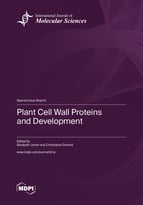Plant Cell Wall Proteins and Development
A special issue of International Journal of Molecular Sciences (ISSN 1422-0067). This special issue belongs to the section "Molecular Plant Sciences".
Deadline for manuscript submissions: closed (31 May 2019) | Viewed by 119653
Special Issue Editors
Interests: plant; cell wall biology; development; evolution; proteomics; post-translational modification; cell wall architecture; protein/protein; protein/polysaccharide interaction
Special Issues, Collections and Topics in MDPI journals
Interests: plant; developement; evolution; terestrialisation; cell wall; peroxidase; reactive oxygen species
Special Issues, Collections and Topics in MDPI journals
Special Issue Information
Dear Colleagues,
This Special Issue, “Plant Cell Wall Proteins and Development”, will cover a selection of recent research topics in the field of cell wall biology focused on cell wall proteins and their roles during development. Experimental papers, up-to-date review articles, and commentaries will be welcome.
Plant cell walls surround cells and provide both an external protection and a mean for cell-to-cell communication. They mainly comprise polymers like polysaccharides and lignin in lignified secondary walls and a minute amount of cell wall proteins (CWPs). CWPs are major players of cell wall remodeling and signaling. Cell wall proteomics, as well as numerous genetic or biochemical studies, have revealed the high diversity of CWPs, among which proteins acting on polysaccharides, proteases, oxido-reductases, lipid-related proteins and structural proteins. CWPs may have enzymatic activities such as cutting/ligating polymers or processing/degrading proteins. They may also contribute to the supra-molecular assembly of cell walls via protein/protein or protein/polysaccharide interactions. Thanks to these biochemical activities, they contribute to the dynamincs and the functionality of cell walls. Even though many researches have already been pursued to shed light on the many roles of CWPs, many functions still remain to be discovered especially for proteins identified in cell wall proteomes with yet unknown function.
Dr. Elisabeth JametProf. Christophe Dunand
Guest Editors
Manuscript Submission Information
Manuscripts should be submitted online at www.mdpi.com by registering and logging in to this website. Once you are registered, click here to go to the submission form. Manuscripts can be submitted until the deadline. All submissions that pass pre-check are peer-reviewed. Accepted papers will be published continuously in the journal (as soon as accepted) and will be listed together on the special issue website. Research articles, review articles as well as short communications are invited. For planned papers, a title and short abstract (about 100 words) can be sent to the Editorial Office for announcement on this website.
Submitted manuscripts should not have been published previously, nor be under consideration for publication elsewhere (except conference proceedings papers). All manuscripts are thoroughly refereed through a single-blind peer-review process. A guide for authors and other relevant information for submission of manuscripts is available on the Instructions for Authors page. International Journal of Molecular Sciences is an international peer-reviewed open access semimonthly journal published by MDPI.
Please visit the Instructions for Authors page before submitting a manuscript. There is an Article Processing Charge (APC) for publication in this open access journal. For details about the APC please see here. Submitted papers should be well formatted and use good English. Authors may use MDPI's English editing service prior to publication or during author revisions.
Keywords
- cell wall
- development
- peptide
- plant
- polysaccharide remodeling
- protein
- signaling








